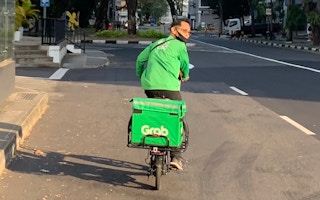Grab, the Singapore-headquartered ride-hailing and delivery app, is working on a plan to decarbonise its operations.
The eight-year-old company has been seeking advice from experts to set science-based targets to reduce its carbon footprint, according to sources familiar with the process. Science-based targets are designed to keep firms’ emissions in line with the Paris Agreement’s goal of limiting global warming below 2°C above pre-industrial temperatures.
Grab sets out on its decarbonisation journey at the same time that Indonesian rival Gojek, with which Grab was in ultimately failed merger talks until January, is working on its own plan to curtail its carbon exposure, starting with an inventory of its emissions. Grab has not shared details of its strategy, which is led by the company’s social impact team.
As with Gojek, a big chunk of Grab’s emissions come from the use of its app. With 187 million registered users in eight countries, Grab is one of the largest digital platforms in Southeast Asia. The app is positioned as “an everyday, everything super app” which offers a range of services beyond transport, including food delivery, online banking, mobile payments, insurance, and even entertainment services such as video streaming.
News of Grab’s carbon-cutting plan emerges the day after Singapore announced a number of measures to green its transport system on Thursday (4 March), including phasing out diesel cars and taxis in favour of “cleaner” fuels by 2025, and rolling out charging stations for electric vehicles (EVs). The road tax for mass-market EVs is to be lowered by next year, so that it’s on a par with combustion engine-powered cars.
Singapore’s transport minister Ong Ye Kung noted that electric vehicles deliver 50 per cent carbon savings “even if the electricity is generated by fossil fuels”. Singapore’s grid is powered almost entirely by natural gas.
Grab has made some moves in the direction of carbon neutrality already, test-driving alternatives to petrol and diesel-powered vehicles. It partnered with Hyundai to trial EVs in Singapore and Indonesia in January, with Honda and Viar to test electric motorbikes in Indonesia last November, and has also trialled e-bikes for deliveries in Thailand.
These pilots could help address limiting factors to EV adoption in Southeast Asia, such as range anxiety, and help get a better understanding of charging behaviour, the company told Eco-Business.
Grab has stated that it is working with governments, manufacturers, and charging infrastructure providers to develop and grow EV infrastructure in Southeast Asia, which is currently limited in scale. “Partnerships with governments are especially needed to co-develop policies to drive and accelerate EV adoption,” the firm said in a statement.
These efforts include sharing driver data with SP Power to work out where best to position EV charging stations in Singapore, and partnering with Indonesian utility PLN to build a network of charging stations in the archipelago.
A key part of Grab’s earlier sustainability positioning was its ride-sharing service, GrabShare, but that offering was suspended during the Covid-19 pandemic. Grab has also been encouraging its delivery drivers to use electrified forms of transport, such as e-scooters or bicycles.
Grab’s decarbonisation drive will dovetail with its other sustainability initiatives, including a reduction in the single-use plastic used for deliveries through an opt-out mechanism for plastic cutlery with food orders. The historical focus of Grab’s sustainability ambitions has been on the social side, through its Grab for Good programme, which aims to bridge the skills gap for drivers with technology.

















